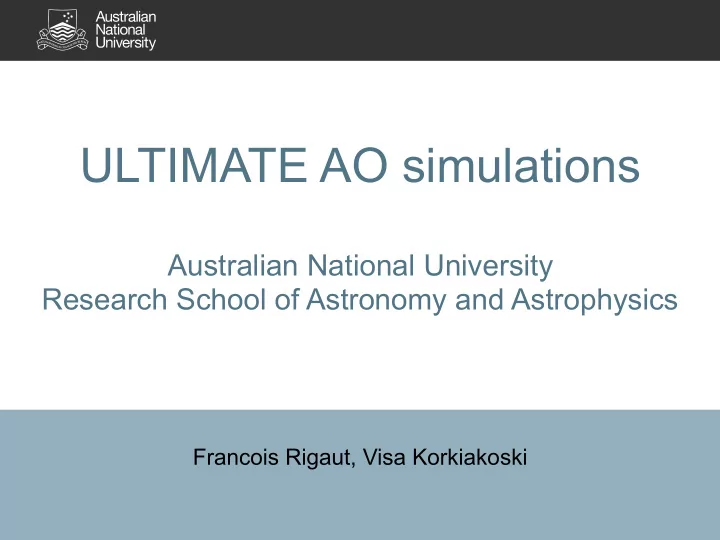

ULTIMATE AO simulations Australian National University Research School of Astronomy and Astrophysics Francois Rigaut, Visa Korkiakoski
Outline Introduction & background Simulation results Next steps Conclusions ULTIMATE-Subaru meeting. January 15-16, 2018 2
System diagram ULTIMATE-Subaru meeting. January 15-16, 2018 3
WFS adaptor flange Science FOV baseline 14’, but can be smaller LGS patrol area in the circle surrounding the science field ULTIMATE-Subaru meeting. January 15-16, 2018 4
WFS adaptor flange Pick one GS in each crescent Margin of ~2” required ULTIMATE-Subaru meeting. January 15-16, 2018 5
Referentials We use instrument Default: 22.5 deg coordinates in our simulations 1-4 NGS: positions do not depend on clocking, pupil rotation and vignetting change 4 LGS: positions change depending on clocking, pupil rotation and vignetting constant Science field evaluated over a grid of 7x7 PSFs ULTIMATE-Subaru meeting. January 15-16, 2018 6
ULTIMATE-Subaru meeting. January 15-16, 2018 7
Simulations in 3 stages 1. System design optimisation • parameters (number of subapertures, WFS pixel size, AO system update rate, controller loop gain) are optimised 2. Final system design performance • system performance evaluated using the optimised parameters 3. Full statistical performance prediction • Based on a set of actual targets, statistical distribution of the Sodium returns, turbulence profiles, many performance points are evaluated ULTIMATE-Subaru meeting. January 15-16, 2018 8
Simulation parameters: fixed 0.448 0.448 ULTIMATE-Subaru meeting. January 15-16, 2018 9
Simulation parameters: turbulence • Cn2 profiles in (Oya, 2014), except low altitudes from (Chun, 2009) ULTIMATE-Subaru meeting. January 15-16, 2018 10
Parameters to scan in phase 1 • Seeing cases 25, 50 and 75 • FOV: 14’ • Number of WFS subapertures: 26, 32 • LGS WFS pixel size: 0.1”—0.8” • LGS WFS FOV: at least 5” • LGS WFS framerate: 100–600 Hz, limited by ORCA Flash ULTIMATE-Subaru meeting. January 15-16, 2018 11
Simulation implementation Use Google Cloud Compute Engine to run YAO simulations Low-cost & convenient platform $0.01 for one CPU hour + storage etc. (preemptible, i.e. may be rebooted) Stage 1 simulations of ~23.000 h: AU$800 ULTIMATE-Subaru meeting. January 15-16, 2018 12
Performance as a function of FOV • Preliminary results for FWHM dependency on the corrected FOV • Reduce baseline FOV of 14’ to 10’: • Gain 10-20 mas 4% in FWHM • Reduce baseline FOV of 14’ to 6’: • Gain 50-80 mas (17%) in FWHM • Even more significant gains at smaller fields ULTIMATE-Subaru meeting. January 15-16, 2018 13
Optimal LGS WFS pixel size • Optimise loop gain & system framerate • FWHM as a function of LGS flux & pixel size • Optimal LGS pixel size 0.6” • LGS flux can be 25% of expected, before performance reduction ULTIMATE-Subaru meeting. January 15-16, 2018 14
Comparison to earlier simulations (Oya, 2014) Compare the case with 30 deg zenith angle Seeing Oya YAO YAO YAO case NEA Seeing GLAO Est. NEA ratio FWHM FWHM ratio 25 0.3 0.47” 0.23” 0.3 50 0.35 0.60” 0.32” 0.4 75 0.5 0.82” 0.51” 0.4 Ratios of noise-equivalent-area (NEA) • Differences between Oya’s and ours: • Oya’s coarse turbulence sampling at altitudes of 0—100 m • Oya’s FOV of 10’ vs. 14’ in our simulations ULTIMATE-Subaru meeting. January 15-16, 2018 15
Comparison to earlier simulations (Oya, 2014) Compare the case with 30 deg zenith angle Seeing Oya YAO YAO YAO case NEA Seeing GLAO Est. NEA ratio FWHM FWHM ratio 25 0.3 0.47” 0.23” 0.3 50 0.35 0.60” 0.32” 0.4 75 0.5 0.82” 0.51” 0.4 Clear message: • GLAO reduces FHWM by 50% • Median seeing GLAO performance: 0.2-0.3” Ratios of noise-equivalent-area (NEA) ULTIMATE-Subaru meeting. January 15-16, 2018 16
Next steps • Discrepancies between YAO & Oya’s simulations • Clarify turbulence normalisation • Finish simulation stages 1—2 • Optimise of NGS WFS pixel size • Decide between visible and infrared detector for NGS WFS (based on expected NGS constellations) • Complete stage 3 of simulations • Compile statistical performance estimates using realistic pointings, turbulence profiles and sodium returns ULTIMATE-Subaru meeting. January 15-16, 2018 17
Simulation stage 3: future results For final performance estimate, we create 1000 samples using realistic settings We obtain: For each sample: performance, e.g., FWHM, for seeing limited & GLAO corrected image Histograms showing the likelihoods for seeing cases and corrections GLAO Seeing FWHM Correction Likelihood ULTIMATE-Subaru meeting. January 15-16, 2018 18
Conclusions Most of simulations for stages 1—2 completed (optimised design parameters) Good agreement with prior simulations, in particular regarding the ratio that GLAO correction will achieve: FWHM reduced by ~50% in all seeing conditions Minor discrepancies to sorted out: make sure our turbulence is not too conservatively scaled (to accurately predict expected absolute GLAO corrected FWHM) Minor tasks remain to complete stages 1—2: NGS WFS pixel size & used wavelength Simulation stage 3, full fledged performance prediction, will commence shortly ULTIMATE-Subaru meeting. January 15-16, 2018 19
Thank you for your attention! ULTIMATE-Subaru meeting. January 15-16, 2018 20
PSF quality as a function of field position. Seeing 50. 20000 iterations 21
Convergence: PSF quality 5000 iterations (1) 5000 iterations (2) 20000 iterations 22
Simulations: convergence >20000 iterations for FWHM >5000 iterations for EE50 23
Recommend
More recommend